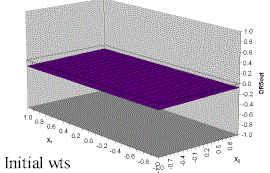Neural Networks

- Article
- Title - "Biologically Inspired Models to Train Neural Networks", Neural Computing & Applications, Springer-Verlag London Ltd, ISSN: 0941-0643, Volume 11, Numbers 3-4, June 2003, pp. 191-202, DOI: 10.1007/s00521-003-0350-7.
- Direct quote of Editor's (Dr. Larry Medsker, American University)
comment - this paper addresses several important problems in applying
neural nets.
- Uniformity of fit: The usual backpropagation algorithm minimizes mean squared error on a training set, but says nothing about how well the learned function matches individual training points. The result may be a function that performs outside tolerance over part of its required domain. Lyons' error constraints algorithm adds error bounds at each training point to the learning algorithm. This insures that the solution uniformly approximates the training set. In practice this means that by choosing a sufficiently dense training set over the domain of interest, one could guarantee that a neural net performed within tolerance.
- Robustness of solution: The uniformity of fit achieved by the error constraints algorithm, together with the bounds on the individual weights included in the error minimization algorithm, result in solutions with good point value agreement and relatively small derivatives. These properties enhance the behavior of the network on the boundary of the training set. This is important, because once in production, unless care is taken, data outside a region well covered by the training set could be submitted to the trained network.
- Determining the right number of hidden layer nodes: The error minimization algorithm presented in Lyons' paper provides a practical way to address this problem, for which guidance has in the past been confined to rules of thumb.
- Existing software: Finally, Lyons' algorithms are important because they are easy to incorporate into existing software, and can easily be put into practice.
- Practice: This paper makes a real contribution to the
practice of using neural nets.
- Training Methods
- Error Minimization Model
- Based on the traditional model of adjusting the weights of a neural network to minimize the sum of the squares of the deviations of the target and computed output.
- Also includes constraints on the size of the weights.
- The model is used in an iterative fashion with successively larger limits on the weights to determine a solution.
- The process of letting the weights grow larger mimics the process in biological systems where the strength of the connection between neurons develops over time.
- Error Constraints Model
- Acceptable deviations of the target and computed output are explicitly specified as constraints and the objective function is to minimize the sum of the squared weights.
- The rationale for this model is also biologically inspired. Since the strength of the connection (weight) between two neurons can be thought of as proportional to the activation voltage (Kosko), the square of the weight can be thought of as proportional to the energy. Thus, this model mimics what nature probably does - use the least amount of energy to encode a fixed amount of information.
- The model uses the same iterative process of successively larger limits on the weights.
- Example - Diminishing Returns - see below.

- Error Minimization Model
- Workbooks
- Right click any of the following links and use the Save Target As option to download the Excel workbook implementations of the corresponding models. If asked for authentication information, just click on cancel.
- These workbooks contain the full Solver model, however, some worksheets containing the run histories have been deleted to reduce download times. Please note that the Solver must be installed in your copy of Excel in order to execute these models.
- Links
- Error Minimization Model for XOR (88KB)
- Error Constraints Model for XOR (95KB)
- Error Minimization Model for Diminishing Returns (133KB)
- Error Constraints Model for Diminishing Returns (206KB)
- Applications
- Forecasting
- Production Control
- Publications - see Selected Articles
(This page was last edited on April 26, 2011.)